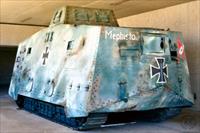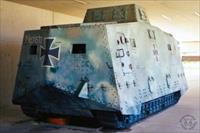MAP CONTROLS: Use slider or mousewheel to zoom, and hold down left mouse button
to drag.
KEY: Location markers are coloured from Green meaning exact to Red meaning
gone or unknown (details here)
|
Unique ID:
|
1
|
|
Added to Database:
|
April 2008
|
|
Last Edited:
|
April 2008
|
|
Type (ID):
|
A7V (10)
|
|
Model (ID):
|
A7V (10)
|
|
Location Category (ID):
|
Queensland Museum (7420)
|
|
Location (ID):
|
Queensland Cultural Centre (7420)
|
|
Serial Number: |
|
|
Registration: |
|
|
Name: |
|
|
Other Identification: |
|
|
Collection Reference: |
|
|
Links: |
|
|
References: |
|
|
Associated Tanks: |
|
Location History:
(see map) |
1: Daimler-Benz AG, Marienfelde, Berlin, Germany (Sole manufacturer)
2: Saint-Quentin, France (First A7V action 21 March 1918)
3: Charleroi, Belgium (Overhaul March-April 1918)
4: Villers-Bretonneux, France (First tank vs tank action 24 April 1918 - abandoned)
5: London, England (Temporary location)
6: Queensland Museum, Queensland Cultural Centre, South Bank, Brisbane, Australia (Current location)
|
Text in original Preserved German Tanks publication:
This A7V, Number 506, was named “Mephisto”. As mentioned above, it took part in the first battle involving A7Vs, on 21 March 1918. Along with Gretchen it went to the Bavarian Army Vehicle Park 20 at Charleroi for overhauling after the battle and remained there until early in April. It then returned to service, but was abandoned during the battle for Villers-Bretonneux on 24 April 1918 - the same battle that saw the first ever tank-versus-tank action. Mephisto became bogged down in a shell hole after receiving a direct hit from artillery fire that killed the driver, and was deliberately blown up the following night by the detonating of an explosive charge in the forward fighting compartment. Three months later the 26th Battalion, Australian Army, had pushed far enough forward to salvage it during the night of 14 July. It was sent first to London and then to Queensland, arriving in Brisbane in 1919 to go on display in the Queensland Museum. It was moved to the Queensland Cultural Centre in 1986.
Mephisto is missing most of its roof and shows signs of being hit several times by artillery fire. It has damage to the gun mantlet and to the vehicle sides, and also has extensive marks from small-arms fire. Mephisto was part of the 3rd Abteilung of the German tank force but unlike other A7Vs it did not carry any Abteilung number on its side, just one Iron Cross marking. “Mephisto” is presumably an abbreviation of Mephistopheles, the devil of the Faust legend; this vehicle carries a marking on the front of a running devil carrying away a British tank. It was sandblasted and repainted in 1972, and restored externally and again repainted for the Australian Bicentennial.
Text in Preserved German Tanks Update:
[No entry]
|
1990
|
| | | |  | | | | |
1: The A7V on display at Queensland
Taken: 1990 (Estimated)
Contributor: T. Royall
Photo ID: 1
Added: 27 April 2008
Filename: Scan_A7V...
Views: 447
Select/Has Priority: 1/0
|
|
|
|
| | | |  | | | | |
2: Rear view
Taken: 1990 (Estimated)
Contributor: T. Royall
Photo ID: 2
Added: 27 April 2008
Filename: Scan_A7V...
Views: 508
Select/Has Priority: 1/0
|
| | | |
|
|